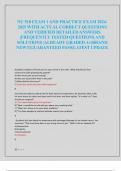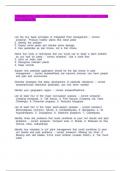NU 518 EXAM 1 AND PRACTICE EXAM 2024-
2025 WITH ACTUAL CORRECT QUESTIONS
AND VERIFIED DETAILED ANSWERS
|FREQUENTLY TESTED QUESTIONS AND
SOLUTIONS |ALREADY GRADED A+|BRAND
NEW!!|GUARANTEED PASS|LATEST UPDATE
A patient complains of knee pain on your arrival in the room. What should your first
sentence be after greeting the patient?
A) How much pain are you having?
B) Have you injured this knee in the past?
C) When did this first occur?
D) Could you please describe what happened?
D
You have just asked a patient how he feels about his emphysema. He becomes silent, folds
his arms across his chest and leans back in his chair, and then replies, "It is what it is." How
should you respond?
A) "You seem bothered by this question."
B) "Next, I would like to talk with you about your smoking habit."
C) "Okay, let's move on to your other problems."
D) "You have adopted a practical attitude toward your problem."
A
. A patient tells you about her experience with prolonged therapy for her breast cancer. You
comment, "That must have been a very trying time for you." What is this an example of?
A) Reassurance
B) Empathy
C) Summarization
D) Validation
D
1|Page
,You are performing a young woman's first pelvic examination. You make sure to tell her
verbally what is coming next and what to expect. Then you carry out each maneuver of the
examination. You let her know at the outset that if she needs a break or wants to stop, this is
possible. You ask several times during the examination, "How are you doing, Brittney?" What
are you accomplishing with these techniques?
A) Increasing the patient's sense of control
B) Increasing the patient's trust in you as a caregiver
C) Decreasing her sense of vulnerability
D) All of the above
D
When using an interpreter to facilitate an interview, where should the interpreter be
positioned?
A) Behind you, the examiner, so that the lips of the patient and the patient's nonverbal cues can
be seen
B) Next to the patient, so the examiner can maintain eye contact and observe the
nonverbal cues of the patient
C) Between you and the patient so all parties can make the necessary observations
D) In a corner of the room so as to provide minimal distraction to the interview
B
The nurse is conducting an interview with a woman who has recently learned that she is
pregnant and who has come to the clinic today to begin prenatal care. The woman states that she
and her husband are excited about the pregnancy but have a few questions. She looks nervously
at her hands during the interview and sighs loudly. Considering the concept of communication,
which statement does the nurse know to be most accurate? The woman is:
a Excited about her pregnancy but nervous about the labor.
B Exhibiting verbal and nonverbal behaviors that do not match.
C Excited about her pregnancy, but her husband is not and this is upsetting to her.
D Not excited about her pregnancy but believes the nurse will negatively respond
to her if she states this.
B
Receiving is a part of the communication process. Which receiver is most likely to
misinterpret a message sent by a health care professional?
A Well-adjusted adolescent who came in for a sports physical
B Recovering alcoholic who came in for a basic physical examination
C Man whose wife has just been diagnosed with lung cancer
D Man with a hearing impairment who uses sign language to communicate and
who has an interpreter with him
C
The nurse makes which adjustment in the physical environment to promote the success of an
interview?
2|Page
,A Reduces noise by turning off televisions and radios
B Reduces the distance between the interviewer and the patient to 2 feet or less
C Provides a dim light that makes the room cozy and helps the patient relax
D Arranges seating across a desk or table to allow the patient some personal space
A
In an interview, the nurse may find it necessary to take notes to aid his or her memory later.
Which statement is true regarding note-taking?
A Note-taking may impede the nurses observation of the patients nonverbal
behaviors.
B Note-taking allows the patient to continue at his or her own pace as the nurse
records what is said.
C Note-taking allows the nurse to shift attention away from the patient, resulting
in an increased comfort level.
D Note-taking allows the nurse to break eye contact with the patient, which may
increase his or her level of comfort.
A
The nurse asks, I would like to ask you some questions about your health and your usual daily
activities so that we can better plan your stay here. This question is found at the
a Summary
b Closing
c Body
d Opening or introduction
D
A woman has just entered the emergency department after being battered by her husband. The
nurse needs to get some information from her to begin treatment. What is the best choice for an
opening phase of the interview with this patient?
A Hello, Nancy, my name is Mrs. C.
B Hello, Mrs. H., my name is Mrs. C. It sure is cold today!
C Mrs. H., my name is Mrs. C. How are you?
D Mrs. H., my name is Mrs. C. Ill need to ask you a few questions about what
happened.
D
During an interview, the nurse states, You mentioned having shortness of breath. Tell me
more about that. Which verbal skill is used with this statement?
A Reflection
B Facilitation
C Direct question
D Open-ended question
D
3|Page
, A patient has finished giving the nurse information about the reason he is seeking care. When
reviewing the data, the nurse finds that some information about past hospitalizations is missing.
At this point, which statement by the nurse would be most appropriate to gather these data?
A Mr. Y., at your age, surely you have been hospitalized before!
B Mr. Y., I just need permission to get your medical records from County
Medical.
C Mr. Y., you mentioned that you have been hospitalized on several occasions.
Would you tell me more about that?
D Mr. Y., I just need to get some additional information about your past
hospitalizations. When was the last time you were admitted for chest pain?
D
In using verbal responses to assist the patients narrative, some responses focus on the patients
frame of reference and some focus on the health care providers perspective. An example of a
verbal response that focuses on the health care providers perspective would be:
a Empathy.
B Reflection.
C Facilitation.
D Confrontation.
D
When taking a history from a newly admitted patient, the nurse notices that he often pauses
and expectantly looks at the nurse. What would be the nurses best response to this behavior?
A Be silent, and allow him to continue when he is ready.
B Smile at him and say, Dont worry about all of this. Im sure we can find out why
youre having these pains.
C Lean back in the chair and ask, You are looking at me kind of funny; there isnt
anything wrong, is there?
D Stand up and say, I can see that this interview is uncomfortable for you. We can
continue it another time.
A
Which of these statements represents subjective data the nurse obtained from the patient
regarding the patients skin?
a Skin appears dry.
b No lesions are obvious.
c Patient denies any color change.
d Lesion is noted on the lateral aspect of the right arm.
C
The nurse is obtaining a history from a 30-year-old male patient and is concerned about
health promotion activities. Which of these questions would be appropriate to use to assess
health promotion activities for this patient?
a Do you perform testicular self-examinations?
4|Page





